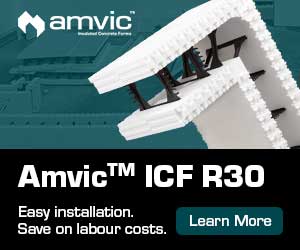Over the past decade, Zero Energy (ZE) homes have quietly gone from research to reality—and they’re becoming increasingly affordable.
For the purposes of this article, a ZE building is defined as a highly efficient structure that produces as much energy as it uses over the course of a year through on-site renewable power generation.
ZE differs significantly from the more widely-known LEED certification program. While both focus on sustainability, ZE is focused exclusively
on energy.
The following pages spotlight two separate “green-built” homes. (A pair of sustainable commercial buildings are also featured in this issue). These case studies demonstrate not only how to achieve sustainability, but the thought processes and rational behind those decisions.
The biggest factor on the road to net zero is energy efficiency, and ICFs are incredibly energy efficient and readily available. They’re also durable, disaster-resistant, and are easily recycled.
However, while ICFs are a great start towards sustainability, they should be coupled with other green technologies to maximize the benefit. Luckily, these technologies are readily available and easily integrated with ICFs.
Complete the Building Envelope
Most of the energy benefits of ICF construction is lost unless the roof and windows are also highly efficient. Emerald City, the Colorado project on the following page, used an EPS roof deck topped with concrete. These are a perfect complement for ICF construction because they offer the same durability, disaster resistance, and energy savings as the walls.
Structurally Insulated Panels (SIPs) are a lightweight alternative
that is still much stronger than conventional construction. A six-inch thick SIP
roof provides an R-Value of 29.5, compared to R-19 for the same thickness of fiberglass batt.
Otten House (pg. 18) used conventional wood trusses and spray urethane foam. This is less expensive than SIPs, but still offers outstanding airtightness, insulation (R-7 per inch), and adds some structural strength by tying the roof deck to the rafters or trusses.
Design and placement of windows is another key. Passive design experts say incoming solar heat through the windows will cover close to 40% of the heat losses if guidelines are followed. Triple-glazed windows are common for ZE homes, although some use double glazing and compensate in other areas. For example, the Otten project used glass primarily on the south side in order to reap the maximum energy benefits.
HVAC Systems
Heating and cooling systems should be carefully matched to the building envelope. Standard-sized equipment will “short-cycle,” turning on and off so frequently that it will negate any energy savings. Smaller equipment costs less upfront, and will ensure maximum efficiency over the long-term, too.
A ground source heat pump takes advantage of the steady temperatures found just a few feet underground to heat and cool the building. Open loop systems use water in a pond, well or river as the heat transfer fluid. Closed loop systems keep the fluid used for heat transfer within the system piping, which can be arranged vertically (as a well) or horizontally (in trenches). Some horizontal systems use coiled pipe to increase the heat transfer per foot of trench.
Highly efficient mechanical systems with zone control are also recommended. Radiant hydronic heat, mini-split A/C units, and evaporative coolers, all work well.
Other Concerns
Efficient appliances, lighting, and water heating equipment is also essential. Tankless water heaters are best if the home will not be constantly occupied. Low-flow showers and faucets will also decrease hot water demands.
Energy efficient lighting will also reduce loads. LED or compact fluorescent bulbs are compatible with most light fixtures. Commercial fluorescent tubes or the LED equivalent are often used in residential construction as well.
A well-designed house can usually reduce energy use to about 20% of code standard. Renewable power makes up the rest. Solar panels (photovoltaic systems) are by far the most common. In some areas, wind generation and modern water-powered Pelton wheels may also be effective.









Trackbacks/Pingbacks